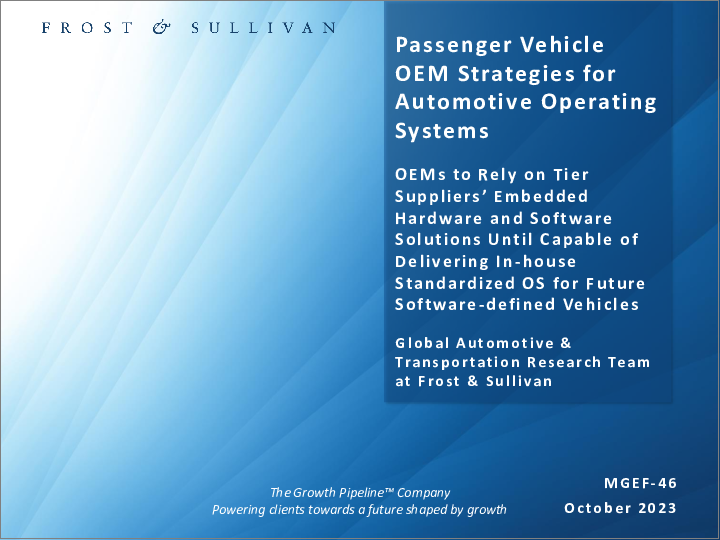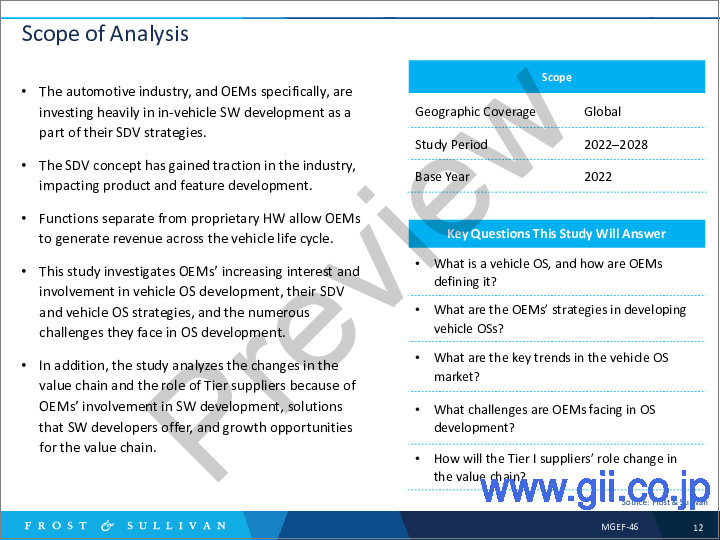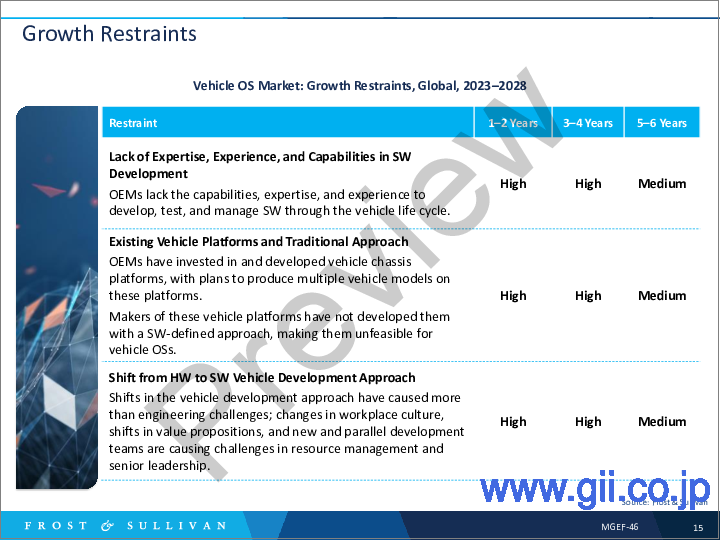|
|
市場調査レポート
商品コード
1375383
自動車用オペレーティングシステム(OS)向け乗用車のOEM戦略Passenger Vehicle OEM Strategies for Automotive Operating Systems |
||||||
|
|||||||
| 自動車用オペレーティングシステム(OS)向け乗用車のOEM戦略 |
|
出版日: 2023年10月12日
発行: Frost & Sullivan
ページ情報: 英文 79 Pages
納期: 即日から翌営業日
|
- 全表示
- 概要
- 目次
OEMは、将来のソフトウェア定義車両(SDV)向けに自社標準のOSを提供できるようになるまで、ティアサプライヤーの組込みハードウェア・ソフトウェアソリューションに依存する
自動車業界は大きな転換期を迎えており、車両開発プロセスを再定義しています。CASEモビリティのコンセプトに関連する数多くのテクノロジーを組込むために、OEMはソフトウェア定義車両(SDV)開発アプローチの採用を選択しました。SDVアプローチでは、OEMは車両のライフサイクルを通じて更新可能な機能や特徴を拡張し、定期的かつ持続可能な収益を得る機会を提供します。
SDVを達成するために、OEMはドメインやゾーンに機能を統合することで、車両の電気/電子(EE)アーキテクチャを再設計しています。OEMは、ソフトウェア開発、特に車両オペレーティングシステム(OS)と呼ばれるソフトウェア主導の特徴や機能を拡張することを可能にするベースソフトウェアプラットフォームに巨額の投資を行っています。
主な問題
- 車両OSとは何か、OEMはそれをどのように定義しているのか?
- 車両OS開発におけるOEMの戦略とは?
- 車両OS市場の主要動向は?
- OEMはOS開発においてどのような課題に直面しているのか?
- バリューチェーンにおけるティアIサプライヤーの役割はどのように変化するか?
- この市場における最大の成長機会は何か?
目次
戦略的インペラティブ
- なぜ成長が難しくなっているのか?
- The Strategic Imperative 8(TM)
- 自動車用OS業界における主要な戦略的インペラティブの影響
- 成長機会がGrowth Pipeline Engine(TM)促進
成長機会分析
- 分析範囲
- 成長促進要因
- 成長抑制要因
- 車両OS市場の主要動向
- OSとは何か?
- 車両OSの進化
- 将来の車両OS:定義と主要機能
- ハイレベルの汎用車両OSアーキテクチャ
- 車両OSの種類
- 車両OSの調達戦略
- SWプラットフォーム開発におけるOEMの課題
- バリューチェーンにおけるティアIサプライヤーの役割の変化
- 車両OSエコシステム
OEMのOS開発戦略
- CARIAD VW.OS
- Hyundai Connected Car OS (ccOS)
- Toyota Arene OS
- MB.OS
- Nio
- Tesla
- Ford
- GM Ultifi
- BMW Neue Klasse
- 典型的なOEM OS戦略
- OEM OS戦略からの主な洞察
OEM OSの活動
- OEM OS戦略のベンチマーキング
- OEMベンチマーキング
オープンソースソフトウェアとコンソーシアム
- AAOS
- AAOSを採用するOEM
- AUTOSARとAGL
- OSとSW開発の協調アプローチ
OSソリューション開発業者
- Blackberry
- Elektrobit
- Red Hat
- Green Hills Software
- Wind River
- Vector Informatik
- OSソリューションのベンチマーキング
成長機会ユニバース
- 成長機会1:SDVが、繰り返し収益を生み出すための新たな道を開く
- 成長機会2:OS開発におけるOEMとSW企業のコラボレーション
- 成長機会3:クラウドコンピューティングと機能の仮想化により、クラウド技術開発者に機会が開かれる
- まとめ
次のステップ
OEMs to Rely on Tier Suppliers' Embedded Hardware and Software Solutions Until Capable of Delivering In-house Standardized OS for Future Software-defined Vehicles
The automotive industry is undergoing a major transition and redefining the vehicle development process. To include numerous technologies tied to the concept of connected, autonomous, shared, and electric (CASE) mobility, OEMs have chosen to adopt the software-defined vehicle (SDV) development approach. With the SDV approach, OEMs extend features and function that they can update throughout the vehicle life cycle, which provides opportunities for recurring and sustainable revenue.
To achieve an SDV, OEM are redesigning vehicle electrical/electronic (EE) architecture by consolidating functions in domains and zones. They are making huge investments in software development, and specifically in a base software platform, that will enable them to extend software-driven features and functions called the vehicle operating system (OS).
Key Issues Addressed:
- What is a vehicle OS, and how are OEMs defining it?
- What are the OEMs’ strategies in developing vehicle OSs?
- What are the key trends in the vehicle OS market?
- What challenges are OEMs facing in OS development?
- How will the Tier I suppliers’ role change in the value chain?
- What are the top growth opportunities in this market?
Table of Contents
Strategic Imperatives
- Why Is It Increasingly Difficult to Grow?
- The Strategic Imperative 8™
- The Impact of the Top 3 Strategic Imperatives on the Vehicle Operating System (OS) Industry
- Growth Opportunities Fuel the Growth Pipeline Engine™
Growth Opportunity Analysis
- Scope of Analysis
- Growth Drivers
- Growth Restraints
- Key Trends in the Vehicle OS Market
- What is an OS?
- Evolution of Vehicle OSs
- Future Vehicle OSs: Definition and Key Functions
- High-level Generic Vehicle OS Architecture
- Types of Vehicle OSs
- Vehicle OS Sourcing Strategies
- OEMs' Challenges in SW Platform Development
- Change of Tier I Suppliers' Role in the Value Chain
- Vehicle OS Ecosystem
OEM OS Development Strategies
- CARIAD VW.OS
- Hyundai Connected Car OS (ccOS)
- Toyota Arene OS
- MB.OS
- Nio
- Tesla
- Ford
- GM Ultifi
- BMW Neue Klasse
- Typical OEM.OS Strategies
- Key Insights from OEM.OS Strategies
OEM OS Activity
- OEM.OS Strategy Benchmarking
- OEM Benchmarking
Open Source Software and Consortia
- AAOS
- OEMs Adopting AAOS
- AUTOSAR and AGL
- Cooperative Approach to OS and SW Development
OS Solution Developers
- Blackberry
- Elektrobit
- Red Hat
- Green Hills Software
- Wind River
- Vector Informatik
- OS Solution Benchmarking
Growth Opportunity Universe
- Growth Opportunity 1: SDVs Opening New Avenues for Repeatable Revenue Generation
- Growth Opportunity 2: Collaboration between OEMs and SW Companies for OS Development
- Growth Opportunity 3: Cloud Computing and Functional Virtualization will Open Opportunities for Cloud Technology Developers
- The Last Word
Next Steps
- Your Next Steps
- Why Frost, Why Now?
- List of Exhibits
- Legal Disclaimer






